In the forthcoming editions of the Speedgroup Club Europe
Newsletters we introduce the car and bike classes that form the FIA &
UEM European Dragracing Championship.
We started with UEM Super
Twin Bike and continue by exploring the fastest of them all, the king
class of dragracing – Top Fuel Dragster.
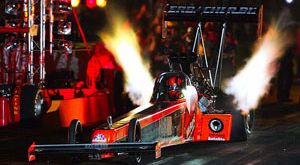
Erbacher during a flaming launch at the Hockenheim
NitrOlympx nightshow
Nations represented in the class:
Denmark  Finland  the Netherlands 
Sweden  Switzerland  United Kingdom 
To get to the bottom with what Top Fuel Dragsters are really
about we asked former Top Fuel Dragster pilot Pelle Lindelöw, Sweden to
share his extensive knowledge. Pelle is a true expert in top fuel racing
and he often acts as a co-announcer at the championship events during the
top fuel dragster sessions. For this article Pelle also made some serious
research and came up what we hope you will find some really interesting
reading!
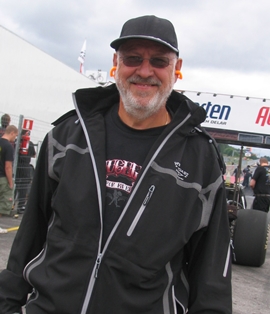
Pelle Lindelöw at the Mantorp Park track
2010
Can You tell us something about the basic facts about
Top Fuel Dragsters? Like performance, power, cylinders, etc.?
PL: The engine develops approximately 7,000 to 8,000 horsepower (up
to 1000 hp per cylinder!). In the Top Fuel class, the engine volume is
limited to a maximum of 500 cubic inches, about 8.2 litres. Engine block
and heads are made of solid aluminium, with loose liners. On top of the
engine is a blower with an injector on top of that. The fuel is injected
into the engine through a number of nozzles in the heads and intake
manifold.
The fuel used in Top
Fuel cars is a mixture of Nitromethane and Methanol. Maximum percentage of
Nitro allowed is 90%, and the fuel is randomly tested after runs. Any team
found to have a mixture above 90% is immediately disqualified.
The car’s minimum weight after
the run is 2300 pounds (1043.3 kg) including driver. The car’s weight is
checked before the race and at random after qualifying and elimination
runs
The rear-end gear ratio is limited to 3.20:1; it may not be
higher or lower.
To keep terminal speeds down, the race distance has
been reduced to 1000 feet (304.8 metres) instead of the classic quarter
mile (402.33m), first in the US and now at some tracks in Europe. This is
sometimes confusing when comparing best elapsed times. Even though the
"real" distance for most people is 402 metres, I believe that 1000 feet
will be established by default, as it has become in the US.
What are the class’s other
defining factors (if you want to add anything to the above):
PL: Noise, power, speed.
Don “Snake” Prudhomme
said: "Loud isn't a strong enough word. It's so overwhelming your brain
can hardly compute what it's hearing and seeing. It's damn near a
religious experience."
Two T/F dragsters leaving the start line have been measured
at 2.3 on the Richter scale and produce around 150 dB of sound. The
pressure wave hits, the ground shakes and four seconds later the cars
cross the finish line at around 500kph (300mph). Nothing matches that, at
least not on a race track ...
A Top Fuel Dragster moves about 16
metres from standstill to 100kph in about 0.7 seconds and will already
reach over 400kph at 200 metres. There’s no other type of piston engine
that develops as much power as a hemi on nitro. I always say to the
doubters that, in order to have an opinion, you must have been there to
experience two nitro cars run the strip, otherwise you can’t understand
what it’s all about and you forfeit your right to express an opinion on
the matter.
How has the class evolved in recent years in terms of product,
performance, the number of teams, etc.?
PL:
The class has enjoyed steady growth in recent years and we can
see 10-12 cars at an FIA event. A couple of years ago there were even more
cars at Mantorp (Veidec Festival) than at an NHRA event the same weekend.
The performance is also improving and the quickest European cars can
actually produce decent E/T’s, also with US measurements. The tracks in
Europe are generally very good, but if you’re looking for a single reason
why we are not at the same performance level as in the States, I would
still put the blame on the track. At an NHRA National Event there are
maybe 1000 cars performing over four or five days, while we have 300-350
cars over three days on this side. It’s obviously hard to achieve the same
quality on the track surface as over there.
The fact that there is a number of
multi-car teams has meant that we’ve seen a lot of new drivers. This is a
great way to bring new personalities into the class. Operating a T/F is
very expensive and requires a big operation, so it may be an option to
lease the “Hot Seat” from an established team. More and more drivers and
bike riders have opted to gain their licences at Frank Hawley's driving
school in the US, and to run one or two races over there. To get licensed
in Europe can take a very long time as the opportunities to make licensing
runs are not that many. A drop of rain at the wrong moment and you have to
wait until next year...

Wearing extensive saftety gear is
everyday routine for the top fuel pilots - Anita Mäkelä, Finland is one of
them
|
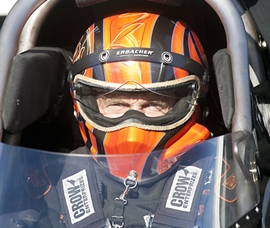
Urs
Erbacher - European Champion 2010
- race ready
What
variables are used to tune the car for the track? What aspect is most
critical?
PL:
The trick is to match all the power in the car to the racetrack
condition (traction). If the track is in perfect condition and all other
conditions are right, you can set the car up very aggressively, on both
clutch and ignition. Good E/T’s will be the result.
On the other hand,
if the track is in a poor condition, you have to step down on power and go
for a more conservative combination, anything you can do to avoid losing
traction and smoking the tires. When you’re racing on a poorly-prepared
strip, it could sometimes be an advantage to have an engine with less
power. It’s hard to take too much power out and still have a good
balance in the motor. What you usually do is take some weight off the
clutch fingers, move the clutch stages out (further up the track), go down
a few degrees on the ignition and so on. Usually you leave the fuel at
90%, running with the same 90% as the engine is basically set up for.

Swedish Top fuel pilot
Micke Kågered´s crew make the last preparations seconds before
launch. Mantorp Park, Sweden 2010
Does driving style change according to track condition? In what way?
PL: Driving a Top Fuel dragster, there is nothing you can do with
the setup during the run as everything is pre-set. When you’re in the
staging lanes waiting to run, if you see other teams having problems
finding traction, your crewchief might sometimes make a last-minute
adjustment before the start. Sometimes conditions can vary between the
lanes, for several reasons – the sun heats up one side more than the
other, or there’s a bump in one lane, or whatever. Then the choice of lane
becomes crucial in eliminations. The driver with the quicker E/T
from the previous round will have lane choice in the next
round.
If you, as a driver, see that others have had problems with
traction, you really have to be alert not to smoke your tires. Not only do
you lose traction, there’s also the risk of engine over-rev (10 – 11,000
rpm). If that happens, you have to ease the throttle, pull the brake as
hard as you can to make the wheels stop spinning, then get back on it
again. That’s pedalling, and it can work, but usually
you lose traction again. The blower belt breaks or some other kind of
misery strikes and the fun is over.
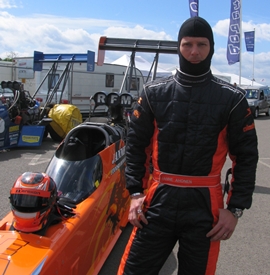
Janne Ahonen, Finland has FIA Championship Top Fuel Racing as a
hobby. He is also a professional ski jumper of
worldclass!
What servicing is normally
done between runs during competition?
PL: The whole design of the engine and transmission is intended to
make the turn-around times in the pits as quick as possible. During
eliminations, the teams has about two hours before the next round. During
those two hours you should have time to tow the car to the pits, jack it
up, and tear down the motor and driveline. The crewchief reads the
data download from the run and analyses it, while the team tears down the
engine and transmission. The whole upper part – blower, injector and heads
– is dismantled. The clutch package is taken out and replaced with a
prepared package of discs and floaters. The oil pan is removed,
pistons, rods and main bearings are checked and the crank is checked for
cracks. Usually you replace all eight piston and rods with fresh units
with new bearings. The team uses spare time later to prepare a set for the
next run. The tires are checked, chutes should be checked and repacked. If
everything is a-ok, you can then re-assemble everything, refill the oil,
fit new spark plugs, make any new adjustments the crewchief has calculated
and prepare for the next run. To achieve this in about an hour, a team
needs 6-8 well-drilled mechanics.
Perishable parts of a Top Fuel
dragster?
PL: Simply put, everything on a T/F dragster is perishable,
including the car itself in the worst case. The more spare parts a team
has in its trailer, the longer it can continue in eliminations normally.
Rear tyres (maximum three or four runs on each pair), crankshaft and main
bearings, clutch parts, blower belts, etc, etc. You soon realise that
what’s expensive about racing a Top Fuel dragster is not the initial
purchase price, but maintaining the operation during races. It takes a lot
of stuff even if everything works as it should. To stay on top you have to
change parts before they give up and therein lies part of the trick.
How fast do you think the ¼ mile can be run under optimum
conditions and what will it take to achieve that? Favourite track / best
racing surface?
PL: It will be incredibly interesting to see how well the amazing
new track at Tierp turns out. With 400 metres of concrete prepped to the
very latest standards, the first true test will be the FIA ??race, June
9–12, 2011. There’s a good chance of seeing record times, and it will be
really interesting to see the cars attack the European records, both speed
and E/T. As I understand, it’s not yet decided whether to run ¼ mile or
1,000 feet, but a record is a record ?
Currently, the quickest and fastest Top Fuel runs in Europe
have taken place at Santa Pod. Will they stand the test at Tierp Arena?
Theoretically, 1,000-foot times and speeds in the order of 3.80/310mph are
possible, similar to the better US performances. Many of the European
teams definitely have the capacity to run really fast. A good example of
that occurred last year when Thomas Nataas drove a few races in the US
with Andersen Racing's car.
Santa Pod is my current favourite track.
Nowhere else is the track so well prepared, so many people in the pits, so
many knowledgeable fans, good racing, variety of cars and bikes, etc.
During our last 10 active years we ran more races in the UK than in
Sweden, or in any other country for that matter. Having sold our operation
to Andy Carter in 2002, I go back to Santa Pod once or twice a year. It’s
fantastic to meet all the old rivals, friends and fans who still remember
me and come up and say hello.
The coolest experience is arguably the
night race at Hockenheim. I can still get goose bumps on my arms just
thinking about it. What an atmosphere, the noise from the grandstands, the
music from the loudspeakers, it’s absolutely unsurpassed. Add the fact
that we won Top Fuel at the NitrOlympix twice, that doesn’t make it any
worse.

Andy Carter in the
Lucas Oil sponsored Andersen Racing Top Fuel Dragster. HockenheimRing,
Germany 2010
European Record (1/4 mile):
Andy Carter, 4.572
sec
@ 320.191mph (515.1kph). Santa Pod, September 2010
|
|
DID YOU KNOW THIS ABOUT TOP FUEL DRAGSTERS?
12,654
Rpm when the blower rotates at maximum
engine rev (engine rpm about 8500).
900
The blower needs so
much power to rotate it, about 900hp is “lost” that way.
16
Spark plugs per engine. The two MSD 44 magnetos together produce some
88 amps – 12 more and we could run a mig welder off them.
569
Turns the crankshaft makes during a full quarter-mile run. Each intake
valve opens 284 times.
100
Gallons per minute from a fuel pump
at full throttle. The engine consumes about 70-80 litres of fuel during a
run, (start-up, burnout, staging and the quarter mile).
39
Minutes it takes to tear down and reassemble a Top Fuel engine. To
address the demands of today’s extremely quick turnaround times, teams use
as many prepared units as possible, pre-assembled clutch packs (discs and
floaters), pistons and con rods, heads, etc. All mechanics have their own
areas of responsibility, tools, etc. If your engine is damaged and time is
short, you replace the complete short block (pan to head) if you have the
resources to do so.
24
Gallons of oil used for warm-up and
race. The oil has special constituents for lubricating a nitro engine.
When the oil is drained after a run you can see that it has been mixed
with nitro which forced its way past the piston rings. The oil has a
similar appearance and texture to Bailey's, and probably lubricates as
well as the drink too. The viscosity used is 50 or 70 grade, depending on
air temperature; thicker oil is used when it’s hot outside.
6
Is the maximum number of clutch discs allowed in a Top Fuel Dragster.
Between each clutch disc lies a steel disc (floater). A multi-stage clutch
is controlled by timers to decrease the slippage and gradually lock the
package of discs and floaters together. The clutch parts harden and last
about three runs before they are discarded.
300 inches
The
wheelbase of a Top Fuel dragster in inches (762 cm). Approximately 76
metres of chrome-moly tubing are used to build a T/F chassis, which must
not be painted, as that will only make it harder to spot cracks in the
welds.
1100
Dollars is the cost for a set of new Goodyear
R36x17.5 rear slicks. If you are lucky, they will last a full mile (1609
metres), or four runs.
58
Beadlock bolts used to attach the
tyres to the rims. Tyre pressure is in the range of 6.5 to 7.5 psi.
4.75
G is the force to which a Top Fuel driver is exposed
leaving the start line. It is more than space-shuttle astronauts
encounter.
543.28
kilometres per hour (337.58mph), the top
speed over 402 metres set by Tony Schumacher in his 2005 NHRA Top Fuel
championship-winning U.S. Army dragster. When Tony pulls the chutes after
the finish line, his body is subjected to -6 g!
53,397
Down
force in Newton, generated by the rear wing at a speed of 523kph. 3560
Newton (3.629 tonnes) is the down force generated by the car's headers
225
Centimetres is the
minimum distance you need to be from the exhaust headers to avoid being
singed by nitro flames from the engine. On the other hand, if you’re
that close to the heat, being singed is the least of your problems…
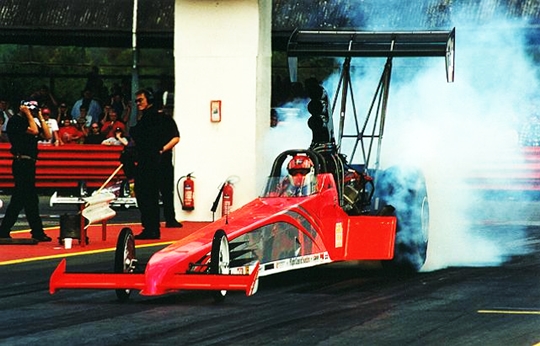
Pelle Lindlöw in action at Santa Pod
Raceway during his long Top Fuel Dragster career
Text by Pelle Lindlöw /
Interview: Åsa Kinnemar
Edited by Robin Jackson.
Photo: Stefan Boman, Patrik Jacobsson,
Ivan Sansom & Rose
Hughes plus Speedgroup
This article is part of the Speedgroup Club Europe Newsletter #3/2011
www.speedgroup.eu
Published by Speedgroup www.speedgroup.eu
All material, text, images and logtypes are the property of Speedgroup AB.
Any use of the above requires permission from Speedgroup.
e-mail: asa.kinnemar@speedgroup.eu
© Speedgroup 2011
|







